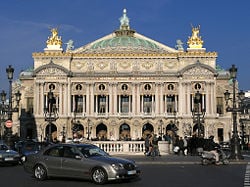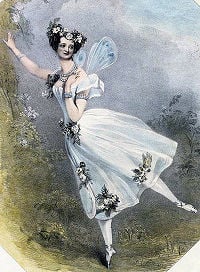Paris Opera Ballet
The Paris Opéra Ballet is the official ballet company of the Opéra national de Paris, otherwise known as the Palais Garnier, though known more popularly simply as the Paris Opéra. Its origins can be traced back to 1661 with the foundation of the Académie Royale de Danse and the Le Ballet de l'Opéra in 1713 by King Louis XIV of France.
The aim of the Académie Royale de Danse was to reestablish the perfection of dance. In the late seventeenth century, using 13 professional dancers to drive the academy, the Paris Opéra Ballet successfully transformed ballet from court entertainment to a professional performance art for the masses. It later gave birth to the Romantic Ballet, the classical form of ballet known throughout the world. The Paris Opéra Ballet dominated European ballet throughout the eighteenth and early nineteenth centuries and remains a leading institution in the art of ballet today.
History
When the Ballet Comique de la Reine—considered the world's first ballet—established Paris as the capital of the ballet world, it sparked the onset of the development of one of the world's most acclaimed institutions. King Louis XIV, who ruled France from 1643 to 1715, made the decision to strengthen Paris' cultural leadership by implementing ballet as a state institution. He would later be the driving force for the transformation of ballet to its professional standard.
Louis greatly enjoyed dancing, and for this reason he took part personally in all the ballets given at his court. Court dancers were generally not professionals. They were noblemen and noblewomen who danced to please their ruler or to stir the admiration and envy of his rivals. Soon, Louis grew dissatisfied with the court's caliber of dancing. Thus, for the purpose of training professional dancers to perform exquisitely for him and his court, Louis founded the Académie Royale de Danse in 1661. With serious training, the French professionals developed skills that had been impossible for the amateurs.
In 1672, the king gave the court's official music composer, Jean-Baptiste Lully, directorship of the Académie Royale de Musique which had been founded as the Académie d'Opéra in 1669. These institutions were maintained lavishly at the expense of the crown. At this time, French ballet and opera were virtually inseparable. Thus, the Academie d'Opera became the leading institution of opera, baroque ballet (which would later evolve into classical ballet), and music in Paris. From 1671 until Lully's death in 1687, the ballet was directed by the dancing master Pierre Beauchamp, most noted for the codification of the five basic positions of the feet in ballet.
In 1681, Mademoiselle La Fontaine (1665-1736) became the first woman to dance on the stage of the Académie Royale de Musique (The Royal Academy of Music) when she premiered in Beauchamps' Le Triomphe de l'Amour (The Triumph of Love). Before La Fontaine's debut as première danseuse (premier female dancer), female roles on the public stage had been taken by young men.
In 1713, the Academy's dancers had become so skilled that the king published a Règlement concernant l'Opéra (government regulations concerning the Opera) which legitimized the Paris Opéra Ballet as a state institution with a permanent resident company of 20 professional dancers (ten men and ten women) to be led by Nicolas de Francine and Gaureaut et Dumont. The Paris Opéra Ballet became an official performance troupe, performing in French theaters for the general public. From that time until the 1810s, the state upheld 12 theaters as the Paris Opéra's principal venues, most of which were destroyed by fires. All of these theaters, regardless of their "official" names, were commonly known as the Paris Opéra or Opéra de Paris.
Criticism
While the Paris Opéra Ballet gained wide popularity, it was not without its critics. The French choreographer Jean Georges Noverre criticized the professional dancers in his 1760 book, Lettres sur la danse, et sur les ballets (Letters on Dancing and Ballet). Noverre complained that the Opéra dancers were far too content with performing steps merely for the demonstration of their technical skills, while neglecting the true purpose of ballet. This purpose, he said, was to represent characters and express their feelings. Noverre declared the art of ballet was to be imitative of life, just as it was for acting.
Noverre urged ballet dancers to stop using masks, bulky costumes, and large wigs to illustrate or explain plot and character. He claimed that the dancers could very well express these things using only their bodies and faces. So long as the dancers did not look strained or uncomfortable doing difficult steps, they could show emotions such as anger, joy, fear, and love.
Out of this criticism of ballet, Noverre developed the ballet d'action, a form of dramatic ballet that told the story of the ballet completely through movement. Noverre himself became the ballet master of the Opéra Ballet in 1776, thanks to the Austrian empress Marie-Therese who had admired his works in Vienna and had spoken about him to her daughter, Queen Marie-Antoinette. However, the Opéra dancers themselves did not readily accept Noverre's new ideas, and later rejected him. He staged a few ballets, such as Apelles et Campaspe (1776), Les caprices de Galathée (1776), Les Horaces (1777), and Les petits riens (1778), but had to leave the company in 1781.
The first Romantic ballet
Nevertheless, Noverre's new dramatic ballet pieces sparked the romantic period and forever transformed the philosophy of ballet. Spectators became more interested in stories of escape from the real world to dream-like worlds or foreign lands. Romantic ballet presented women as ideal and, for the first time, gave them more important roles than men. Male dancers became chiefly porters, whose purpose was to lift the ballerinas (female dancers) and support their leading parts.
On July 23, 1827, an Italian dancer, Marie Taglioni, made her debut at the Paris Opéra Ballet in the Ballet de Sicilien (Sicilian) and aroused great enthusiasm from her audience. This moved her father, choreographer Filippo Taglioni to create La Sylphide—credited as the first romantic ballet—for Marie in 1832. Designed as a showcase for Marie's talent, La Sylphide was the first ballet where the ballerina danced en pointe (on toes) for the work's entirety.
Marie danced the title role of the Sylphide, a fairy-like being, in a costume that set a new fashion for women dancers. It included a light, white skirt that ended halfway between her knees and ankles. Her arms, neck, and shoulders were bare. Marie Taglioni, with her dreamlike style, became the greatest star of the Paris stage at that time.
Later nineteenth century
The Paris Opéra Ballet remained the leading European dance company through the early nineteenth century. Its principal dancers during this time included Fanny Elssler and Carlotta Grisi, who won fame in the title role of Giselle beginning in 1841. Its male stars included Jules Perrot and Arthur Saint-Léon.
With the spread of ballet's popularity abroad, especially in Russia, the company's leadership waned in the second half of the nineteenth century. The arrival of Jacques Rouché as director in 1914 revived its reputation, however. Rouche introduced avant-garde productions featuring Russian guest artists such as Anna Pavlova, Michel Fokine, and Bronislawa Nijinska. In 1930 Serge Lifar became the company's director and the principal performers included such stars as Marjorie Tallchief and George Skibine.
Recent Years
Rudolf Nureyev became the director of dance of the Paris Opera Ballet in 1983. Although his strong personality caused major conflicts with some of the principal dancers of the company, he boosted the careers of many young dancers such as 'étoiles' (stars) Sylvie Guillem in 1984, Isabelle Guerin and Laurent Hilaire in 1985, Manuel Legris in 1986, Elisabeth Maurin in 1988, and Kader Belarbi in 1989. The years of Nureyev marked a golden era of the Paris Opera Ballet.
Among the new ballets of the repertory were several works by Antony Tudor, the premiere of Maurice Bejart's Arepo (1986), Somewhat Elevated (1987), Neumeier's Magnificat (1987) and Wilson's new version of Le Martyre de Saint-Sebastien (1989). Nureyev also staged his own new versions of Raymonda, Swan Lake, The Sleeping Beauty and The Nutcracker.
Patrick Dupond, who had been a principal dancer of the company since 1980, became the director of dance in 1990. Dupond organized a striking "defile" (review) of the company, including all the former principals still alive.
From 1995 to 2014, Brigitte Lefevre, a former dancer of the company and co-founder of the Theatre du Silence with choreographer Jacques Garnier, served as director. She invited some of the most preeminent choreographers, such as William Forsythe, Angelin Preljocaj, Saburo Teshigawara, and John Neumeier.
Turbulent times for the company followed with Benjamin Millepied as director from November 2014 until he resigned on July 15, 2016.
Aurélie Dupont took over the direction of the ballet company on August 1, 2016. She had been Danseuse Étoile (principal dancer) from 1994 to 2015.
Choreographers
- Jean Dauberval: La fille mal gardée (1789)
- Pierre Gardel: Télémaque (1790), Psyché (1793), Le jugement de Pâris (1793), La dansomanie (1800)
- Philippe Taglioni: La Sylphide (1832)
- Jules Perrot: Giselle (1842)
- Jean Coralli: Giselle (1842)
- Carlo Blasis
- Arthur Saint-Léon: Coppélia (1870)
- Louis Meranté: Sylvia (1875)
- Serge Lifar: Les Créatures de Prométhée (1929), Icare (1935), Istar (1941), Suite en blanc (1943)
- Rudolf Nureyev: Raymonda (1983), Swan Lake (1985), Romeo and Juliet (1984), The Nutcracker (1985), La Bayadère (1992)
- Maurice Béjart: Arepo (1986)
- William Forsythe: In the Middle, Somewhat Elevated (1987), Woundwork I, Pas./Parts (1999), Blake Works I (2016)
- Angelin Preljocaj: Le Parc (1994), Annonciation (1996), MC/14-22 (Ceci est mon corps) (2004), Le Songe de Médée (2004)
- Roland Petit: Notre-Dame-de-Paris (1965), Clavigo (1999)
Pina Bausch: Le Sacre du printemps (1997), Orpheus et Eurydice (2005)
- Wayne McGregor: Genus (2007), L'Anatomie de la sensation (2011)
- Sasha Waltz: Romeo and Juliet (2007)
- Saburo Teshigawara: Air (2003), Darkness is Hiding Black Horses (2013)
- John Neumeier: La Dame aux Camélias (2006), Song of the Earth (2015)
Note: works listed were created for the Paris Opera Ballet
ReferencesISBN links support NWE through referral fees
- Guest, Ivor. Le Ballet de l'Opéra de Paris: Trois siècles d'histoire et de tradition. Opera national de Paris, 2001.
- Reyna, Ferdinando. A concise history of ballet. Thames and Hudson, 1965. Grosset & Dunlap Publ., 1965. ASIN B000F8E91S
- Uferas, Gerard. In the company of stars: the Paris Opera Ballet. Flammarion, 2007. ISBN 9782080300003
External Links
All links retrieved November 18, 2022.
- Official Site of Paris Opera Ballet www.operadeparis.fr.
Credits
New World Encyclopedia writers and editors rewrote and completed the Wikipedia article in accordance with New World Encyclopedia standards. This article abides by terms of the Creative Commons CC-by-sa 3.0 License (CC-by-sa), which may be used and disseminated with proper attribution. Credit is due under the terms of this license that can reference both the New World Encyclopedia contributors and the selfless volunteer contributors of the Wikimedia Foundation. To cite this article click here for a list of acceptable citing formats.The history of earlier contributions by wikipedians is accessible to researchers here:
The history of this article since it was imported to New World Encyclopedia:
Note: Some restrictions may apply to use of individual images which are separately licensed.






